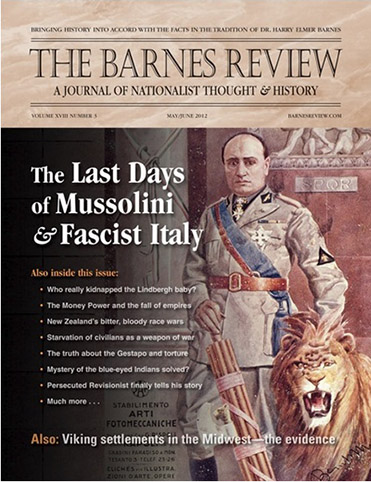Description
The Barnes Review
A JOURNAL OF POLITICALLY INCORRECT HISTORY
May/June 2012 ❖ VOLUME XVIII ❖ NUMBER 3
TABLE OF CONTENTS
ITALY SINKS INTO BLOODY CIVIL WAR
By Joaquin Bochaca. The fall of Italy was a tragic time, yet few Americans really knew what was happening inside Italy in the waning days of WWII. The fact is that Italian society had devolved into a bloody civil war. Revisionist Joaquin Bochaca has studied the era and gives TBR readers his insights detailing what went on in Italy after Mussolini was freed from Allied imprisonment and started a new fascist government in the north, while the south went on an orgy of anti-fascist violence.
RUSH TO JUSTICE IN THE HAUPTMANN CASE
By Philip Rife. When the baby of Charles and Anne Lindbergh was kidnapped in what has been called the crime of the century, German immigrant Bruno Richard Hauptmann was arrested. He was tried, convicted and sent to the electric chair. The case was an international sensation, but Hauptmann had no chance to prevail. Evidence was fabricated, suspects ignored, witnesses tampered with. The jury too was caught up in the mass hysteria of the time and ready to convict. However, a rational look at the evidence decades later shows an innocent man most likely was executed.
VIKINGS IN MINNESOTA & THE DAKOTAS?
By William White. Increasingly we are faced with evidence that the Vikings were not only active visitors in the American heartland but may have had lasting settlements there. Over the last century or so, for instance, the remains of 13 Viking ships have been reportedly found in one Midwest waterway. What validity do these claims have? What artifacts have been recovered? Is it all a hoax?
WHY ROME FELL—AND AMERICA WILL
By Greg Felton. There are lessons America must learn from the decline and fall of the ancient Romans. Two of the reasons Rome fell were its financial profligacy and its inescapable cycle of perpetual war. Are we fated to follow in their footprints to our doom, or can we still save our republic?
NEW ZEALAND’S RACIAL WARS
By Arthur Kemp. The people the European discoverers found in New Zealand were a race of Polynesians called Maoris. In many ways very primitive, at the same time the Maoris were probably the toughest fighters the Pacific Ocean had to offer. And thus nearly every encounter between early European explorers and settlers was tense and potentially violent. In at least one case, a group of convicts being transported to the islands of New Zealand was attacked and most of the 70 people on board were captured, killed and eaten.
THE USE OF STARVATION IN WARFARE
By Daniel W. Michaels. In the Dark Ages, it was not unusual to besiege a fort or even a whole town to force the people inside to either surrender or starve to death. But those were barbaric days of yore. Modern, civilized nations would not commit such atrocities today—or would they? Unfortunately, mankind has made little or no progress in the moral field since Medieval times—if anything, we have become worse. Here is a whirlwind tour of starvation warfare through modern history.
THE TRUTH ABOUT THE GESTAPO
Conclusion to the Series by Vincent Reynouard. In this final installment to our three-part series on the Gestapo, the work of Revisionist author and researcher Vincent Reynouard is used to present a completely different view of the notorious Gestapo of the WWII era. Is what we have been taught about the Gestapo as fraught with error and exaggeration as the holocaust of the same time period? It appears so. . . .
AN ANTI-SEMITE CONFESSES
By Mero Aldrigen. Michael Collins Piper, a longtime member of TBR’s consulting editorial board, had the intestinal fortitude to pen a book about anti- Semitism, pro-Semitism and Semitism, whatever all those terms really mean. See a review of Piper’s new tell-all book with a bold title. . . .

